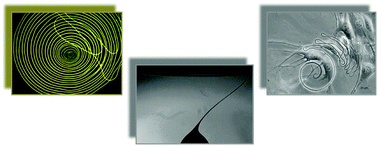Spiral formation at the microscale by μ-pyro-electrospinning†
Abstract
Spiral shapes occur frequently in nature as in the case of snail shells or the cochlea – the auditory portion of the inner ear. They also inspire many technological devices that take advantage of this geometry. Here we show that μ-pyro-electrospinning is able to control whipping instabilities in order to form spiralling fibres (down to 300 nm thick) directly on a support with true microscale regularity. The results show that polymer concentration plays a key role in producing reliable and long spirals. We investigate the cell response to these spiral templates that, thanks to their true regularity, would be useful for developing innovative cochlea regeneration scaffolds.


 Please wait while we load your content...
Please wait while we load your content...